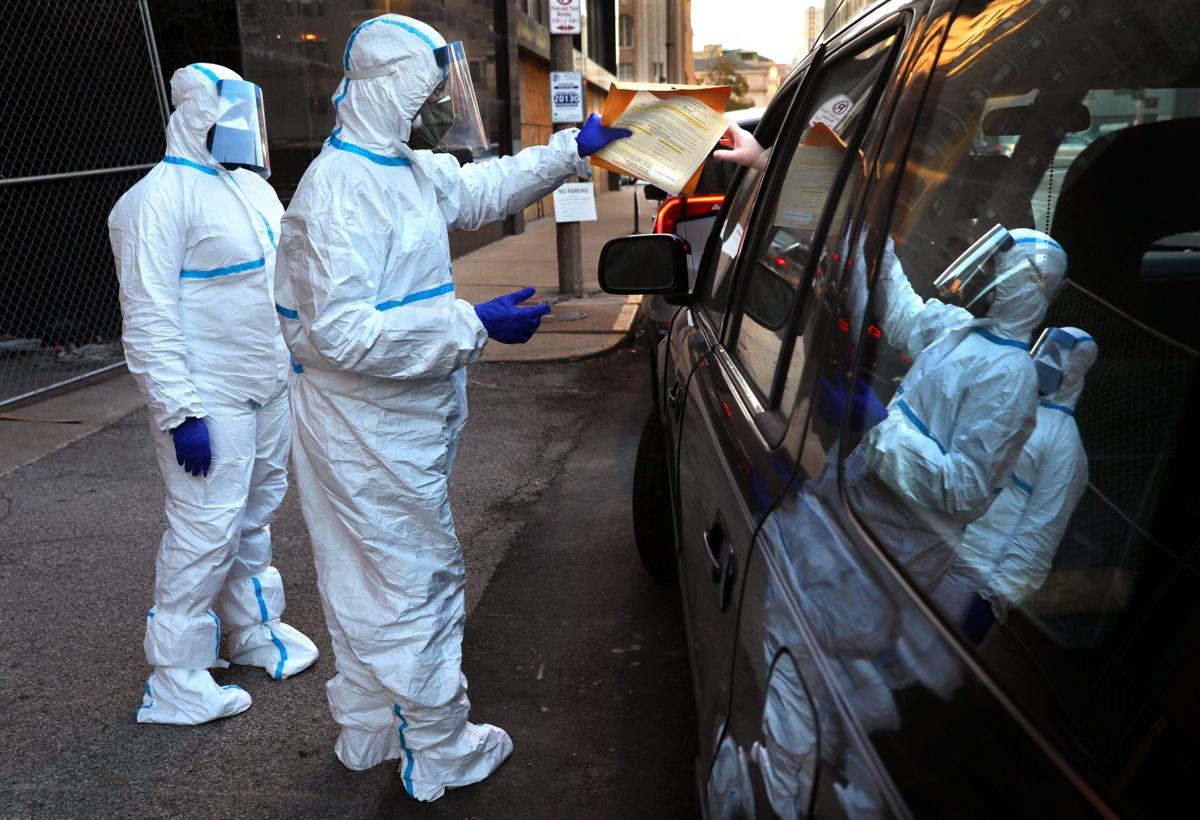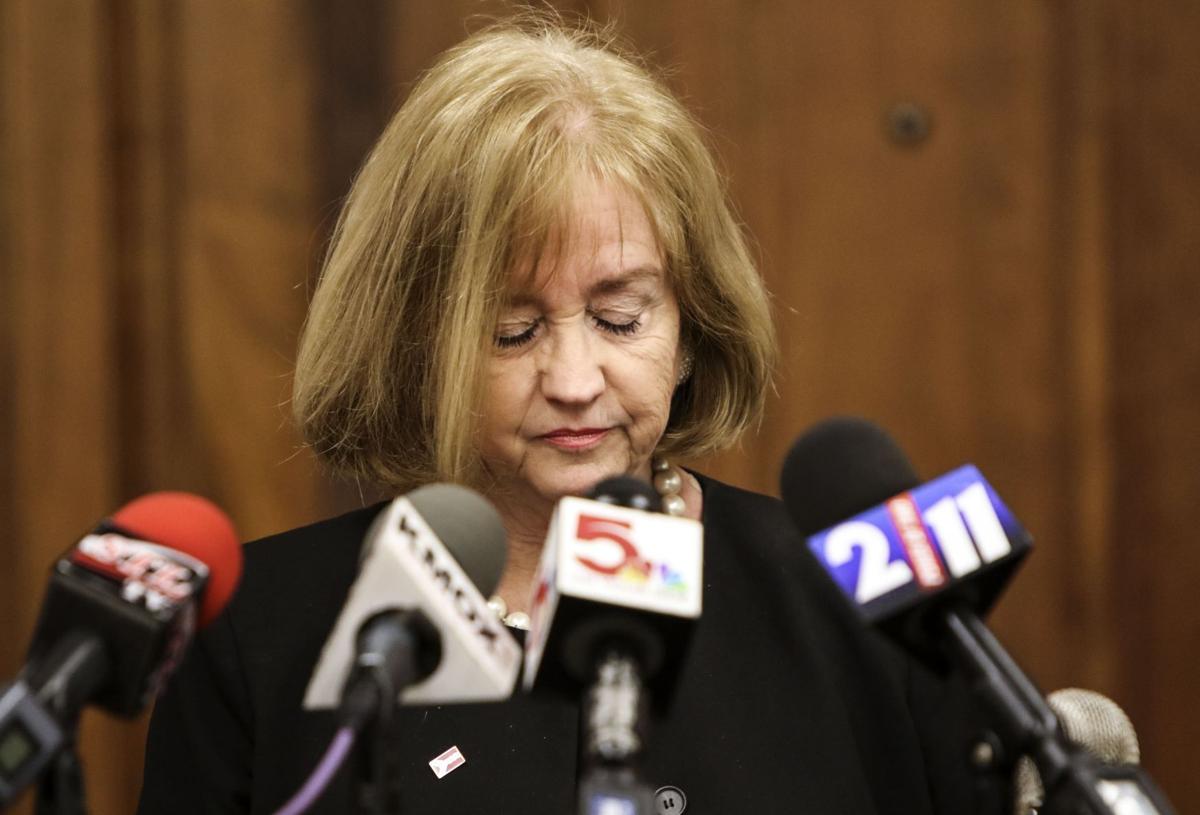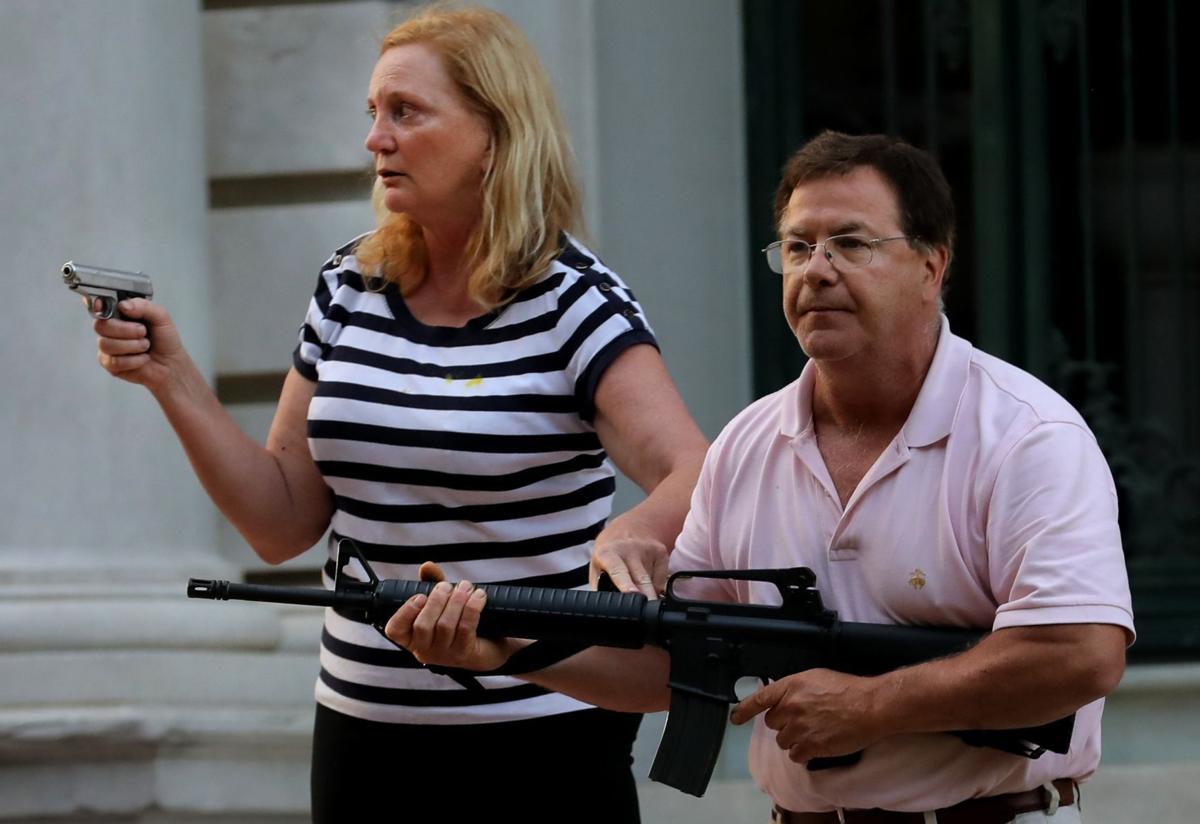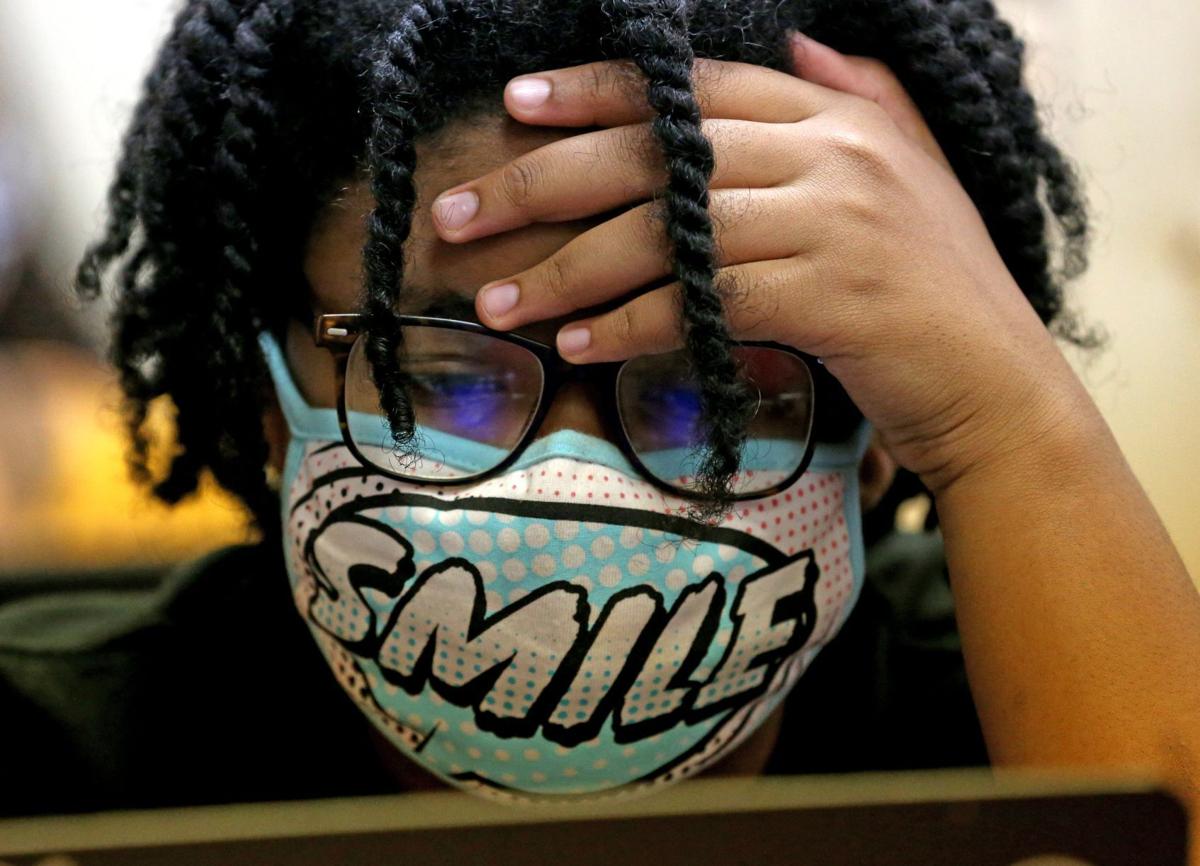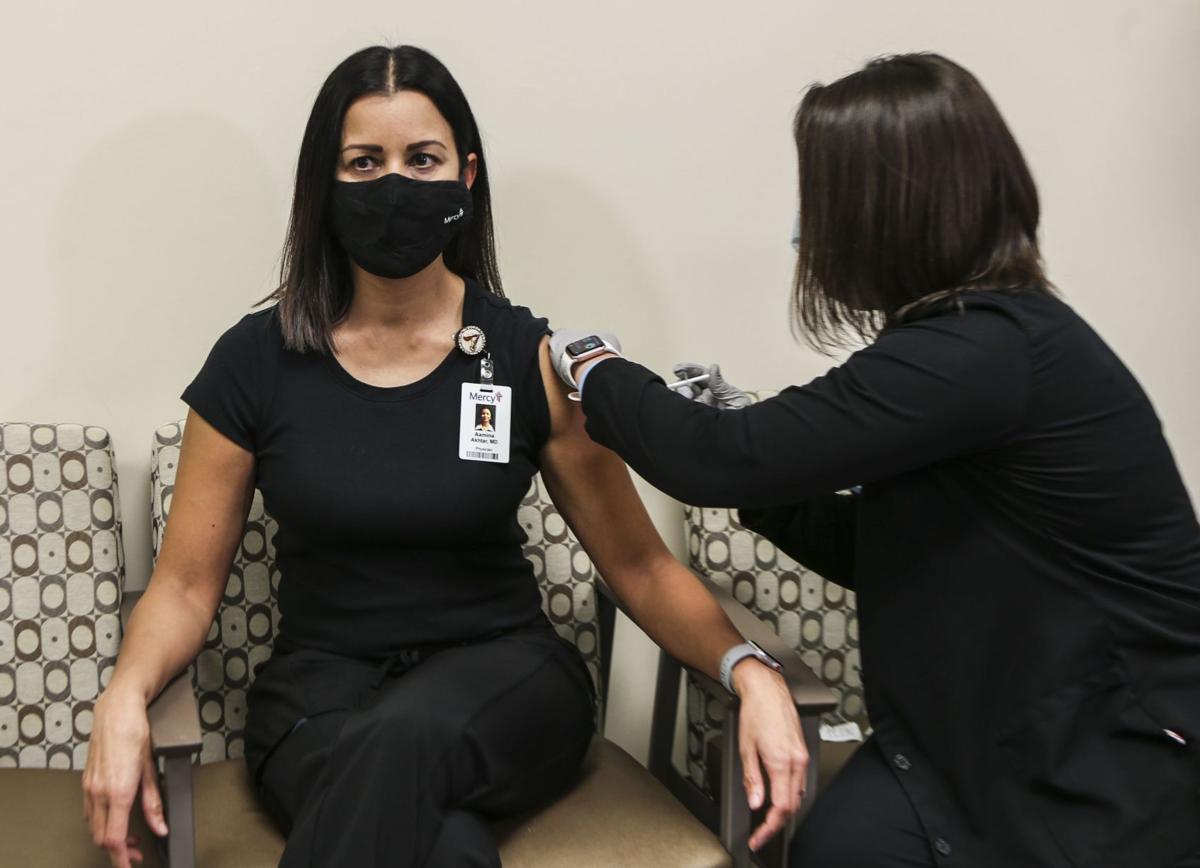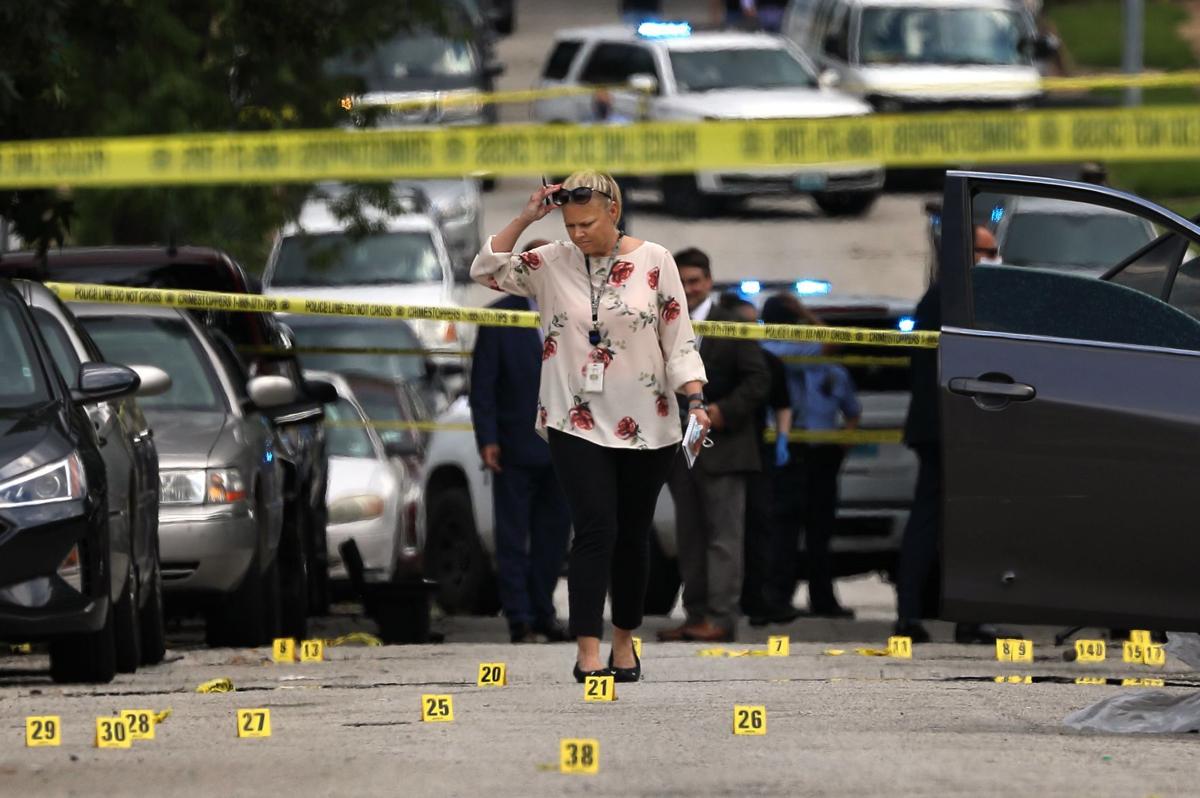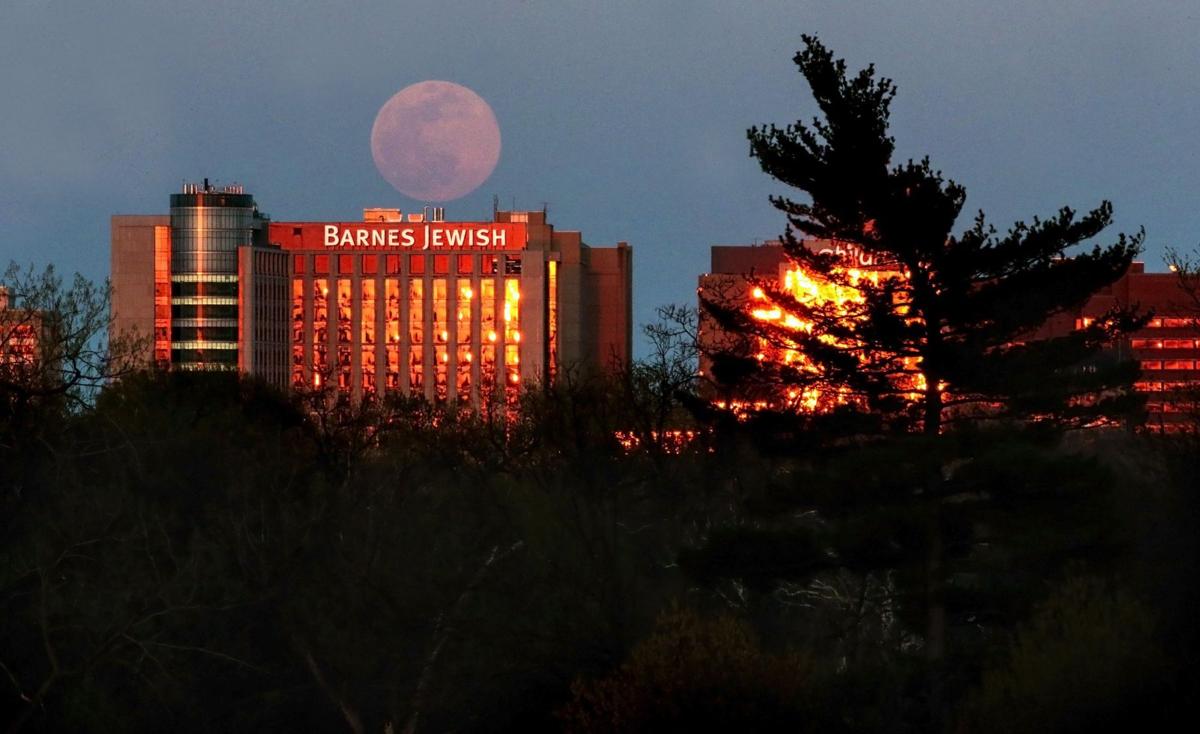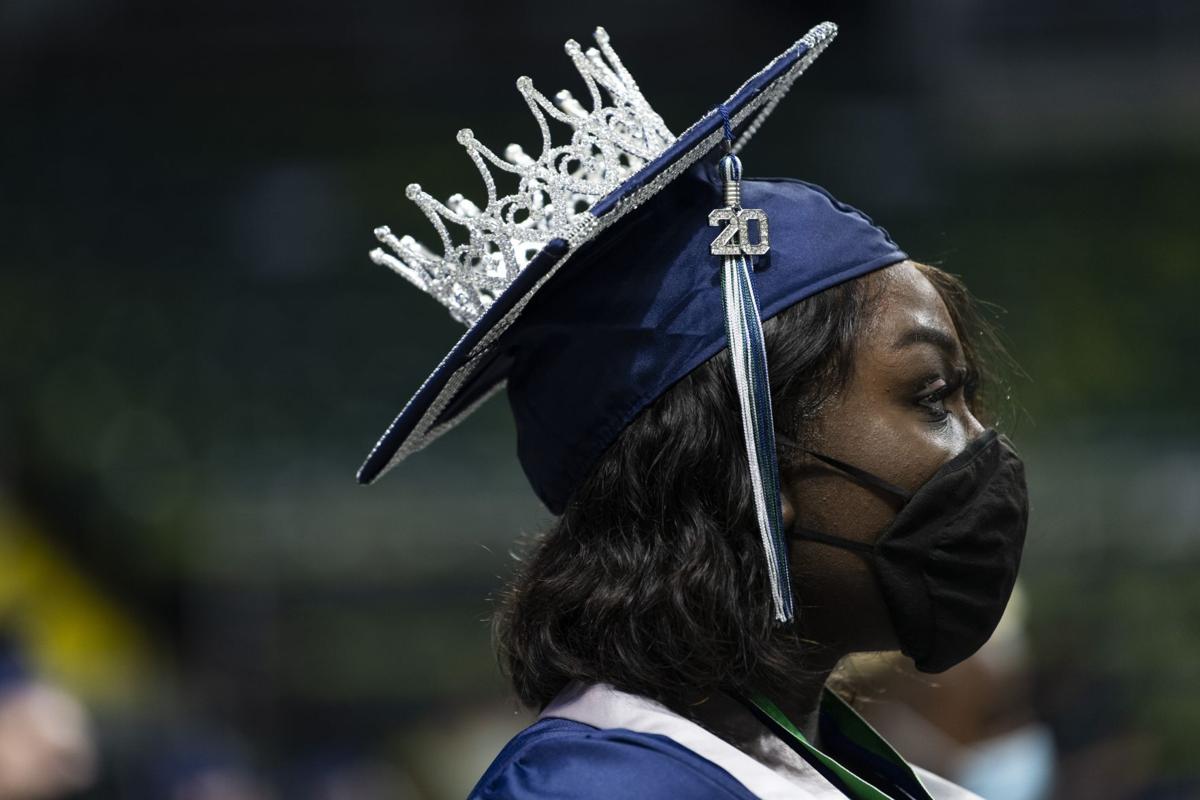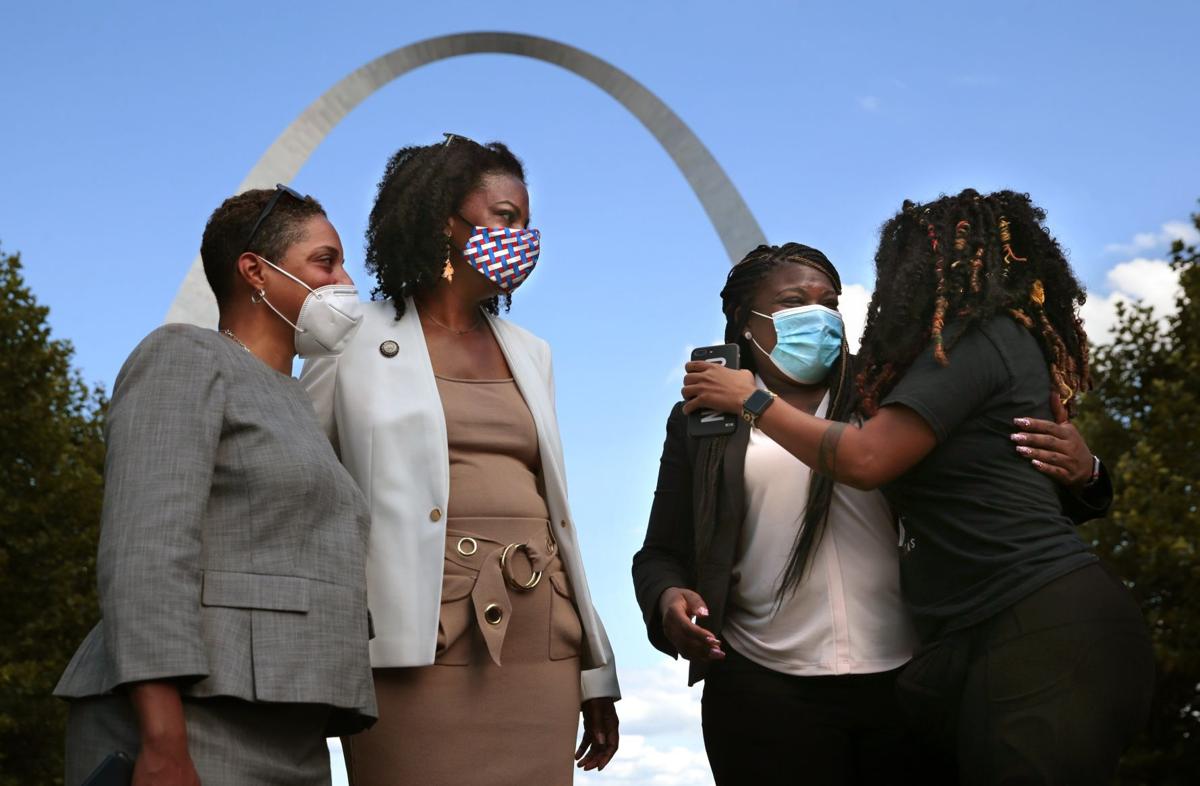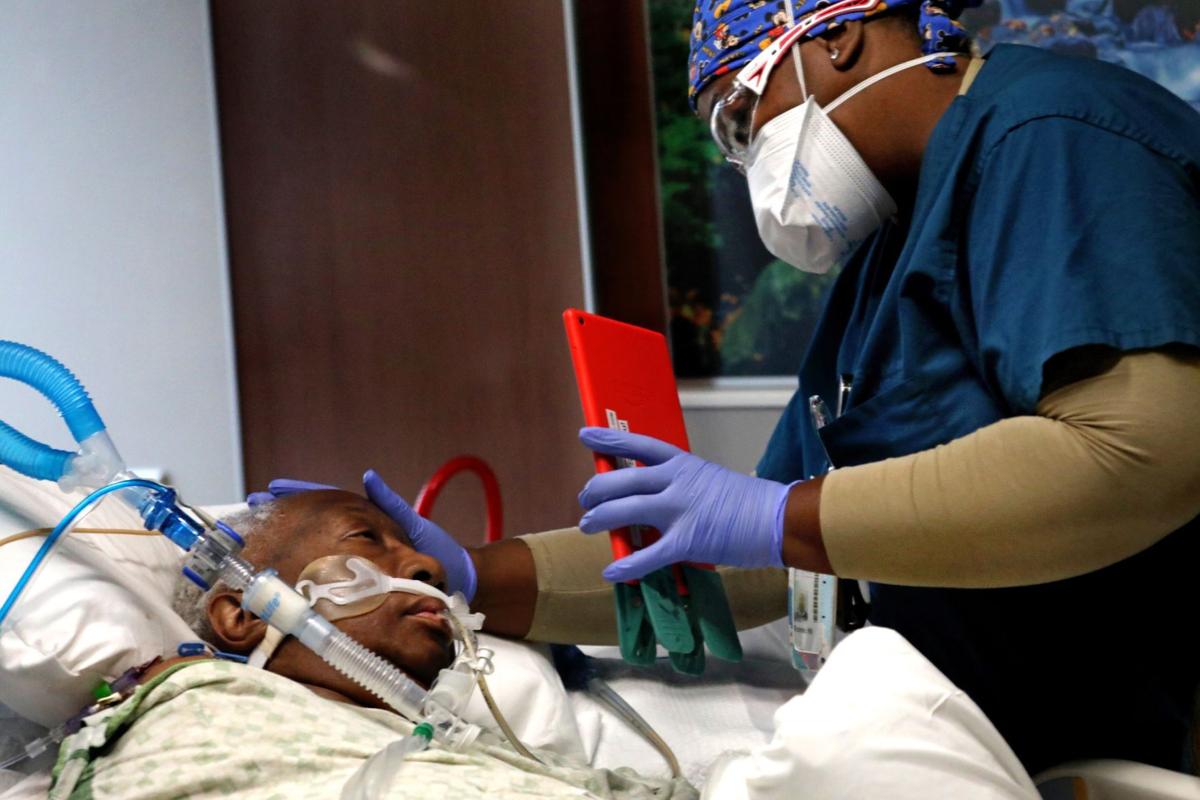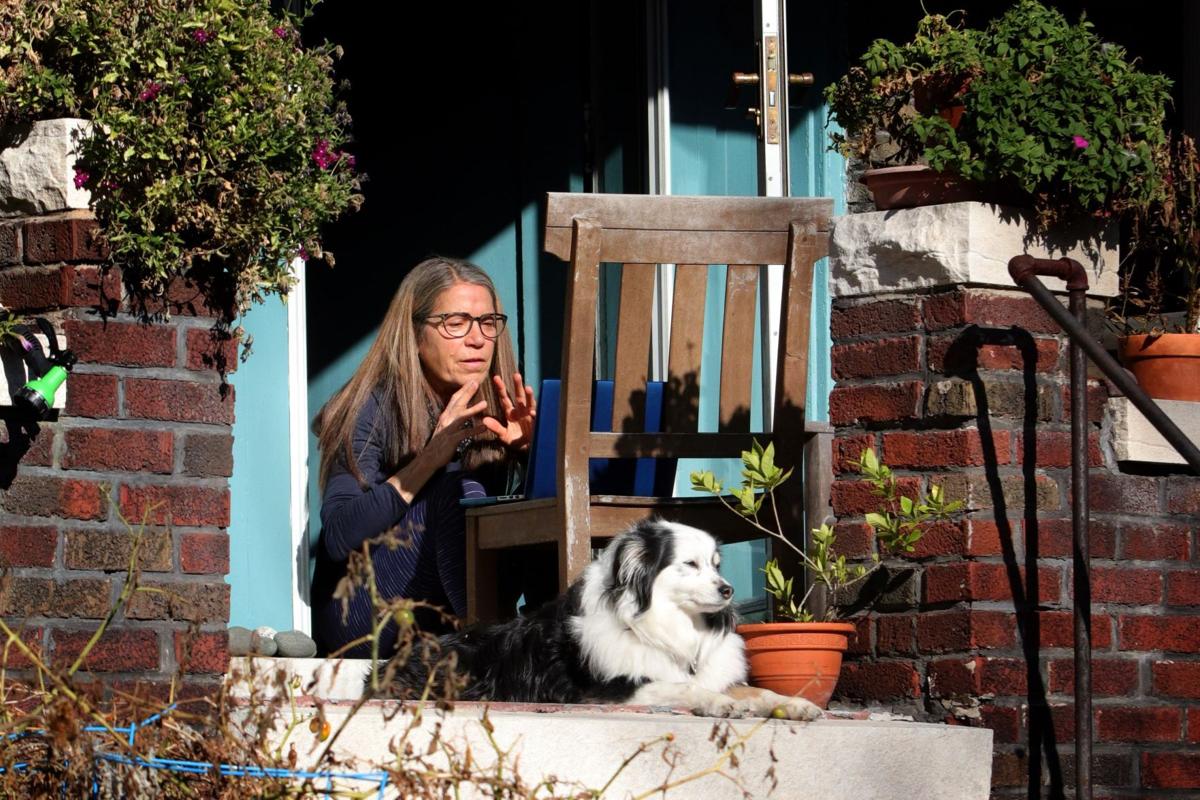26 December 2020
Ann Webb Camp, left, and Clemintine Banks of the St. Louis Board of Election Commissioners hand a ballot to a voter as COVID-19 positive people do curbside voting on Locust Street, around the corner from board offices in downtown St. Louis on Monday, Nov. 2, 2020. Photo by Robert Cohen, rcohen@post-dispatch.com
St. Louis Mayor Lyda Krewson becomes emotional while speaking about the city of St. Louis during her announcement that she will be retiring and not running for reelection at a press conference in the Mayor’s office at City Hall in St. Louis on Wednesday, Nov. 18, 2020. Krewson stated that she made the decision with family to retire, because she is nearing the age of 70. Photo by Cheyenne Boone, cboone@post-dispatch.com
A marijuana leaf is photographed on Saturday, Feb. 22, 2020, at the University City home of a grower who is cultivating in his basement legally for personal use. Photo by Christian Gooden, cgooden@post-dispatch.com
“It’s uncomfortable but I wear it all day to stay safe,” said Jade Bugett, 12, talking about her mask as she types her science report on Wednesday, Sept. 23, 2020, at Hardin Middle School in City of St. Charles. The City of St. Charles School District opened all its schools five days a week for in-person learning for the school year. Hardin Middle School has had zero cases COVID-19 since school started. Photo by Laurie Skrivan, lskrivan@post-dispatch.com
Dr. Aamina Akhtar, an infectious disease specialist and the chief medical officer of Mercy Hospital South, is administered the first COVID-19 vaccine in the St. Louis region by nurse Karla Herrington at the hospital in St. Louis County on Monday, Dec. 14, 2020. Photo by Cheyenne Boone, cboone@post-dispatch.com
Police investigate the scene of a triple homicide in the 5500 block of Floy Avenue in St. Louis on Wednesday, July 29, 2020. The yellow numbered markers show the exact location of evidence, such as the bullet casings on the street. Photo by David Carson, dcarson@post-dispatch.com
A supermoon rises over the Barnes Jewish Hospital medical center, including the Siteman Cancer Center and St. Louis Children’s Hospital, as seen from Art Hill in Forest Park on Tuesday, April 7, 2020. Photo by Robert Cohen, rcohen@post-dispatch.com
Gabrielle Pounds listens to commencement speakers during the Timberland High School graduation ceremony at The Family Arena in St. Charles on Saturday, July 25, 2020. Safety protocols included a temperature check, cutting arena capacity to 50% and mandating masks for all visitors. Photo by Chris Kohley, ckohley@post-dispatch.com
Cori Bush gets a hug from activist supporter Ohun Ashe, right, as Bush joins Circuit Attorney Kimberly Gardner, left, and Treasurer Tishaura Jones following a press conference at the Gateway Arch involving three Black women that won their races on Wednesday, Aug. 5, 2020. Photo by Robert Cohen, rcohen@post-dispatch.com
A car burns at the corner of Martin Luther King Boulevard and Tucker Boulevard on Tuesday, June 2, 2020. After a peaceful day of protests things devolved into a full-scale riot with looting, fires, general lawlessness and four police officers shot in St. Louis. Photo by David Carson, dcarson@post-dispatch.com
“I know her daughter does not like seeing her mother in this condition, but she wants her to know she supports her,” said RN Ronnie Childs, who soothes COVID-19 patient Charline Smith as she video chats with her daughter Tandra McWright on Monday, Nov. 23, 2020, in the intensive care unit at SSM Health DePaul Hospital–St. Louis in Bridgeton. Photo by Laurie Skrivan, lskrivan@post-dispatch.com
Ellen DeFilippo, an art teacher at Forsyth School, teaches her fourth-graders from her front porch, through her laptop propped on a dining room chair, in the Hi-Pointe area of St. Louis on a breezy, unseasonably warm day, Thursday, Nov. 19, 2020. At her side, enjoying the sun is her dog, Pipa. Photo by Hillary Levin, hlevin@post-dispatch.com
A year that will be known for death, confinement and deprivation began in a mellow flourish of self-indulgence.
Nearly 700 people waited outside HCI Alternatives in Collinsville at 7 a.m. on Jan. 1 for the first chance to legally buy marijuana for the pleasure of it. Some had gathered 10 hours before to buy pre-rolled joints, gummies and chocolate bars.
The Illinois Legislature had approved the sale of recreational marijuana to commence in 2020. Illinois still prohibits smoking weed in public. Missouri allows only medical marijuana. But it was a bi-state crowd outside HCI.
Dan Watts of St. Charles enjoyed the comforting atmosphere of the first day. “I don’t feel judged,” Watts said. Mitchell Rochette of St. Louis County said he was part of “a historic day.”
Said Jesse Halfhill of Litchfield, “I don’t want to go to a guy who sells meth just to get some weed.”
Illinois reported $3.2 million in sales on the first day. On day two, HCI ran out of Platinum Valley flower and Tropicana Cookies. It briefly closed two weeks later to restock.
By July, customers had bought $239 million in marijuana in Illinois, with $52 million to the state treasury. HCI, now Illinois Supply and Provisions, is one of two dispensaries in the Metro East.
Missouri customers return home at their own risk, but St. Louis Circuit Attorney Kim Gardner does not prosecute possession cases of 100 grams or less, or about 3.5 ounces. In 2018, Missouri voters endorsed medical marijuana in 2018. On Oct. 17, the N’Bliss dispensary near Manchester made the first sale to a customer with a doctor’s approval.
Wear a ‘dang mask’
The first time COVID-19 made the Post-Dispatch front page was on Jan. 21, with word that a “new coronavirus” in China could be spread by human contact. But it was far away.
The first St. Louis-area case was of a college student from Ladue who returned in March from Italy, where the virus was raging. There was community uproar after her father and sister attended a high school dance after health officials said they cautioned them to stay home. Back then, the United States had all of 250 cases in 18 states, with 13 deaths.
The pandemic quickly overtook the country, overwhelming daily life; 2020 became the year of the facemask. Wearing them, or not, became a symbol of one’s trust in medicine, sense of community and political sentiment. By year’s end, the virus had killed more than 300,000 Americans.
The first local victim was Judy Wilson-Griffin, a hospital nurse, on March 20. By mid-May, COVID had killed 525 St. Louis-area patients, peaking at more than 20 per day.
Missouri and Illinois issued stay-at-home orders in March. St. Louis officials limited bars and restaurants to carryout service. Shoppers stripped supermarkets of toilet paper. Masks were hard to find. Homebound workers and students moved to the web.
In July, the city and county required mask-wearing, but most Missouri counties did not. The Jefferson County Health Board mandated them, then quickly retreated before an outburst of opposition. A sign at a Jefferson County gun shop: “Masks are for crybabies, Democrats and robbers.”
Illinois required masks, but Missouri Gov. Mike Parson resisted. “If you want to wear a dang mask, wear a mask,” Parson told cheering supporters. He and his wife later contracted the virus.
By summer, many businesses were allowed to reopen. The region’s number of hospitalized COVID patients leveled off but soared in November, tripling to more than 1,000 daily. St. Louis County Executive Sam Page ordered restaurants closed again. The Jefferson County Health Board finally adopted the mask order.
On Dec. 14, hospital workers began receiving the vaccine being rolled out nationwide. Among them was Sandy Roy, laboratory manager at Christian Hospital in north St. Louis County.
“This is progress for the whole world,” Roy said.
By year’s end, in the two-state metro area, COVID had killed nearly 3,000 people and infected an additional 165,000.
Bruno’s journey
Maybe the bear just wanted to see what he could see.
A black bear, soon dubbed Bruno by internet fans, was spotted in Wisconsin heading south on June 5. He ambled into Illinois five days later, swam the Mississippi River into Iowa, and then back again into Illinois, where hundreds of people watched and photographed him near Barry, Illinois, about 20 miles east of Hannibal, Missouri.
Still traveling south, Bruno swam the Mississippi a third time and was spotted in a cornfield near Elsberry, about 60 miles northwest of St. Louis. By then, his following on a Facebook page titled “Keeping Bruno Safe” had swelled to 150,000 worldwide.
Specialists versed in the ways of bears said the length of Bruno’s trek was unusual, even for young male bears. They estimated Bruno’s age at 4 years or more. And by then, they said, bears have satisfied most of their long-range wanderlust.
But not Bruno. On July 5, he was spotted near Wentzville, 40 miles south of Ellsberry. State conservation agents had been watching from a distance, letting Bruno find his way. But he got too close to the busy intersection of Interstate 70 and U.S. 40-61 and his adoring 400 human followers. Agents tranquilized Bruno, tagged him for identification and moved him to what they called a “suitable habitat.”
That probably means the Ozarks wilderness, home to most of Missouri’s growing number of bears, estimated to be as many as 840. But a warning to Bruno and his fellow bears — Missouri plans to hold a limited black bear hunt next October.
Airport lease stalls
The up-and-down flight path for leasing St. Louis Lambert International Airport to a private operator is grounded again, perhaps for good. Will it yet find its wings?
Former St. Louis Mayor Francis Slay proposed leasing the airport in 2017 with the backing of Rex Sinquefield, the uber-wealthy libertarian active in local politics and policy. Sinquefield underwrote the city’s exploration of offering the airport for a long-term lease.
The city has owned the region’s primary airport in North County since 1928, when it bought Col. Albert Bond Lambert’s St. Louis Flying Field. Sinquefield and his allies said the city could earn a billion-dollar windfall in lease payments and get a better airport. Critics doubted there was that much untapped gold beneath the nation’s 34th busiest airport.
Area business leaders were split on the idea. One year ago, Mayor Lyda Krewson suddenly pulled the plug on the whole idea. On Jan. 15, the city’s Estimate Board — consisting of the mayor, Comptroller Darlene Green and Aldermanic President Lewis Reed — voted 3-0 to kill it.
But in May, the St. Louis NAACP and the St. Louis-Kansas City Carpenters Regional Council announced a petition drive, heavily financed by Sinquefield, to force the issue onto the city ballot in November. The NAACP saw a windfall of cash to rebuild north St. Louis. The Carpenters saw jobs.
Central to their vision was a requirement that any future airport operator pay the city $1 billion up front. Sinquefield would get back the $44 million his group spent on all the planning. Critics, including Alderman Cara Spencer, D-20th Ward and a candidate for mayor, said a lease would squander the city’s biggest asset.
In July, aldermanic president Reed proposed a rival version of the call for a public referendum. A consultant on the privatization plans announced an effort to recall Spencer from her aldermanic job. Both efforts flopped. In September, the NAACP and the Carpenters ended their petition drive, blaming COVID-19.
Sinquefield still likes the idea, adding only, “Now is not the right time.”
Voters expand Medicaid
Ever since Congress adopted the Affordable Care Act, also known as Obamacare, in 2010, Missouri’s Republican-majority Legislature has buried Democratic efforts to embrace one its key features — expanding the Medicaid program for poor people. GOP legislators called it burdensome and socialistic. President Barack Obama’s name on the law didn’t help.
This year, stalwart supporters organized a petition drive to bypass legislators and put the question before voters. Their proposed Amendment 2 to the state constitution would require Missouri to offer Medicaid to more low-income residents.
Unlike federal Medicare for older people, states run their own Medicaid programs, primarily with federal money. Missouri’s Medicaid eligibility is among the nations’ lowest, effectively covering only impoverished mothers and children. Amendment 2 boosts eligibility for a family of four to an income of $36,000 from $5,800.
Gov. Mike Parson, a Republican, opposed the idea. In May, petitioners met the threshold to put the issue before voters. They wanted it on the Nov. 3 general election ballot. Parson acted quickly to put it on the Aug. 4 primary, when a lower voter turnout could make it easier to defeat. But he said he’d follow the will of the voters.
Backers included the Missouri Hospital Association, Missouri Chamber of Commerce and the St. Louis Regional Chamber. Among opponents were the Missouri Farm Bureau and Americans for Prosperity-Missouri. A last-minute attack mailer alleged that undocumented immigrants would be “flooding Missouri hospitals.” (They’re ineligible.)
Voters adopted Amendment 2 by nearly 7 percentage points, making Missouri the 38th state to join Obamacare. It had strong support in urban areas but fared poorly in rural counties, where the GOP is strongest.
Parson had warned that expanding Medicaid would force the state to cut programs or raise taxes. With state tax revenue falling because of the pandemic, there is conservative sentiment to simply not fund it when the Legislature returns on Jan. 6.
“I just don’t see it happening next year,” said Sen. Bob Onder, R-Lake Saint Louis.
Guns and protesters
A brief encounter this summer across a manicured lawn was fraught with conflict over the rights to property, guns and protest. Nobody got hurt, but that became the least of it.
On the afternoon of June 28, a group of protesters seeking the resignation of Mayor Lyda Krewson took a short cut to her Central West End Home by walking through Portland Place, one of the city’s storied private streets north of Forest Park.
“Private property. Get Out!” shouted resident Patricia McCloskey from her porch. She pointed a small pistol. Nearby, her husband, Mark, held an AR-15 rifle.
After some cursing and video recording, the protesters moved on. But with the nation embroiled in protest and violence over the death of George Floyd in Minneapolis, the encounter quickly became world news.
Floyd had died on May 25 after being pinned at the neck beneath a police officer’s knee. Protests erupted across the country, including in St. Louis. On June 1, looters struck about 60 local businesses. A convenience store downtown was burned to the ground.
The McCloskeys said they feared for their lives and were defending their property. Protesters said they never threatened anyone.
St. Louis Circuit Attorney Kim Gardner, running for reelection on police reform, said peaceful protesters were met by “violent assault” and promised to investigate. Gov. Mike Parson, running for reelection on law and order, said he’d pardon the McCloskeys if they were convicted.
Gardner charged both McCloskeys with unlawful use of a weapon, a felony. President Donald Trump praised the couple’s actions. They spoke from their home to the Republican National Convention.
Gardner’s successful campaign in the August Democratic primary had cited the McCloskey case in a fundraising email. The couple petitioned to have her office disqualified from the case.
On Dec. 10, a St. Louis circuit judge barred Gardner’s office from prosecuting Mark McCloskey. A similar request is pending for his wife.
Cooking up murder
It was a made-for-TV murder involving a reality TV family.
Robbie Montgomery, a former backup singer for Ike and Tina Turner, opened her first Sweetie Pie’s restaurant in Dellwood in 1996, offering a soul food menu. Success led to her starring in a reality-TV show, “Welcome to Sweetie Pie’s,” which ran on the Oprah Winfrey Network from 2011 to 2016. She was “Miss Robbie.” Also cast were her son, James “Tim” Norman, and a grandson, Andre Montgomery Jr., who was Norman’s nephew.
The show featured their Southern cooking and tales of Norman’s effort to overcome his past as a teenage armed robber. In one episode, he and his mother visit a prison where he had served time.
But on March 14, 2016, Andre Montgomery, 21, was fatally shot near Fairground Park. Norman and his mother visited the murder scene for the show. “Since Andre’s passing, I haven’t gone through this part of the city,” Norman said.
The murder was unsolved until August, when Norman, 41, was arrested in Jackson, Mississippi, on federal charges of conspiracy in a murder-for-hire. A former girlfriend, dancer Terica Ellis of Memphis, was accused of luring Montgomery to the murder scene. Federal investigators said both were in St. Louis that day. They said Ellis returned to Memphis with $9,000.
They said Norman, who had bought a $450,000 life insurance policy on Montgomery in 2014, tried without success to cash it. Federal authorities charged insurance agent Waiel Yaghnam, who sold the policy, with conspiracy to commit fraud. A fourth defendant, Travell Hill, was charged in November, allegedly for tipping Ellis to Montgomery’s location.
The web of possible motives grew in September with disclosure of a 2015 burglary of Robbie Montgomery’s North County home, when $220,000 in cash and jewelry were stolen. Detectives suspected Andre Montgomery. When they interviewed him in 2016, Montgomery pointed to Norman for the burglary.
Four days later, Montgomery was shot dead.
Black women win
St. Louis Treasurer Tishaura Jones called the results “Black girl magic.”
The setting was a victory rally near the Gateway Arch for herself, city Circuit Attorney Kim Gardner and Cori Bush after the Aug. 4 Democratic city primary. The star was Bush, 44, an activist who had just defeated 10-term U.S. Rep. Lacy Clay. He and his father, William Clay, had represented Missouri’s 1st Congressional District since 1968.
“Two weeks ago, I called Cori and said, ‘Can you imagine what would happen if all three of us won,’” Jones recalled. “I said, ‘Girl, the ground would shake.'”
Jones, a former state representative who has been city treasurer since 2013, easily won renomination. Gardner, who was elected four years ago on a police-reform platform, decisively turned back a challenge from a former assistant prosecutor.
It was Bush’s upset over Lacy Clay that made national news. Bush entered politics as a bullhorn-wielding activist during the Ferguson protests in 2014. She challenged Clay in 2016 and lost by 20 percentage points.
But she increased her support among progressive Democrats and in 2019 was portrayed along with U.S. Rep. Alexandria Ocasio-Cortez, D-New York, in a Netflix documentary called “Knock Down the House.”
Bush called for “defunding the police.” Said Clay, “Now is not the time for amateur hour.”
The 1st District covers the city and much of North County. Bush won the city, rolling up big margins in the South Side wards where many young progressives live. Clay narrowly won in the county, but she beat him overall by 3 percentage points.
Shortly before the Nov. 3 general election, Bush said she would work to “defund the Pentagon.” Delighted Missouri Republicans expressed outrage.
Tweeted Bush, “I’m used to these kinds of attacks.”
Krewson bows out
Mayor Lyda Krewson appeared ready to seek reelection, even as her first term covered a tumultuous four years at City Hall and on the streets.
Krewson, 68 and a former alderman for her Central West End neighborhood, became the city’s first female mayor in 2017, replacing Francis Slay, who had served a record four terms. Krewson narrowly won the city’s Democratic primary that year, edging city Treasurer Tishaura Jones by 879 votes in a seven-candidate field. It was obvious at City Hall that Jones, the daughter of former city comptroller Virvus Jones, was itching for a rematch.
Last January, Krewson said she was “absolutely” planning to run. But on Nov. 18, three days before filing opened for the March 2021 election, Krewson announced, “A new mayor will lead us forward.”
Quickly filing for the job were Alderman Cara Spencer, D-20th Ward, Aldermanic President Lewis Reed, and Jones. This will be Spencer’s first bid for mayor and the third for Reed.
But when voters go to the polls on March 3, the election will be in a new format, compliments of a City Charter amendment that voters adopted on Nov. 3.
Candidates for mayor, comptroller and aldermanic seats will not run as members of political parties. The top two vote-getters go to a runoff one month later. And if a nonpartisan format isn’t radical change enough, the new system includes this rare feature: Voters can cast votes for any and all of the candidates, and each vote carries the same weight. Dubbed “approval voting,” backers are aware of its use only in Fargo, North Dakota. It does not apply to the “county offices,” such as treasurer and sheriff.
A progressive group gathered petitions to put the issue before voters. The Board of Aldermen went on record 18-8 against it, with Black aldermen opposed and the progressive bloc generally for it. Spencer voted “present.”
Jones endorsed it. The plan easily passed in the city, losing only in north side wards.
Whoever emerges the winner will become the city’s 47th mayor.
Homicides soar
The year 2020 was barely 20 minutes old when St. Louis police found two men shot to death in a car near Benton Park. “It was every caliber going off,” said a neighbor who has learned to distinguish such things.
On Jan. 2, the toll rose to five killed by gunfire. The year 2019 had ended with 194 homicides, the second-highest of the decade. January was a bad start for another bloody year.
As 2020 comes to an end, there have been 251 homicides in the city, rivaling the record of 267 killings in 1993 during the “crack wars,” when the city population was almost 20% larger.
There were 53 killings in July, a record for that month. As bodies accumulated, members of law enforcement, university faculties, social agencies and activist groups offered theories — job losses due to COVID, too many guns and drug deals, overworked police, inadequate prosecution, rising homicide rates nationwide, racism, disrespect for life. St. Louis police Chief John Hayden ascribed to a “perfect storm” of factors.
Compounding frustration was the low rate of solving these murders, at less than 30%. Detectives said the pandemic exacerbated the usual reluctance of witnesses to talk; residents did not want to interact with police.
St. Louis is a perennial national leader in homicides, partly because of a self-inflicted statistical oddity. The “Great Divorce” of 1876, forever splitting St. Louis city from county, prevented the city from enlarging its boundaries. Adding the county’s nearly 1 million people would greatly reduce the murder rate. That is of no comfort to victims’ families.
Across the city’s 62 square miles, 11 of its 54 neighborhoods had seven or more homicides each in 2020. Walnut Park, in far northwest city, accounted for at least 25. There were none in 27 neighborhoods. More than half of the victims were 29 or younger, and about 90% were Black.
In 2020, the city rolled out its $7 million Cure Violence street-intervention program, designed to reduce conflicts before the guns are drawn. In another initiative, the feds hit town with 50 agents to help overworked city cops. Civic leaders met. More shots were fired.
The year has five days to go.
Source: stltoday.com
Our Score
Click to rate this post!
[Total: 0 Average: 0]
